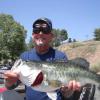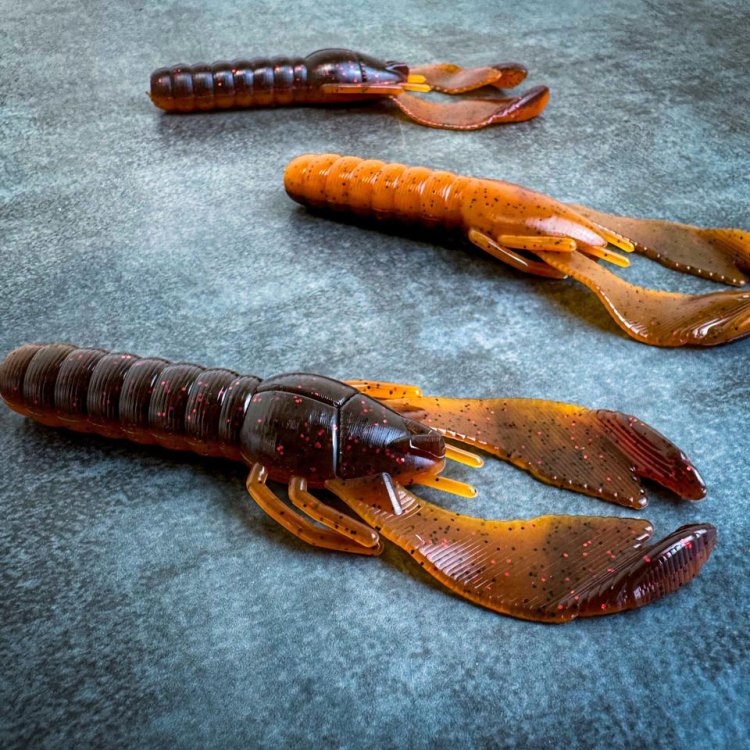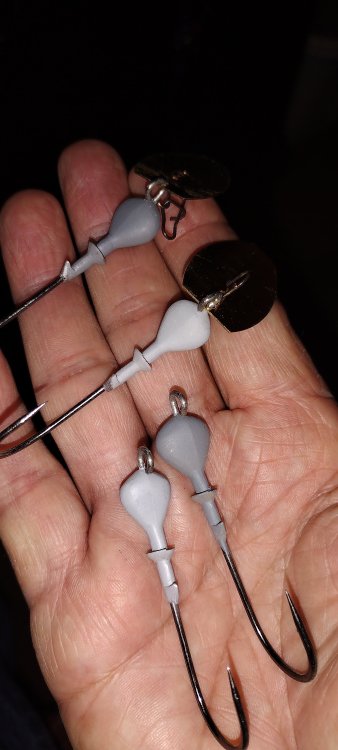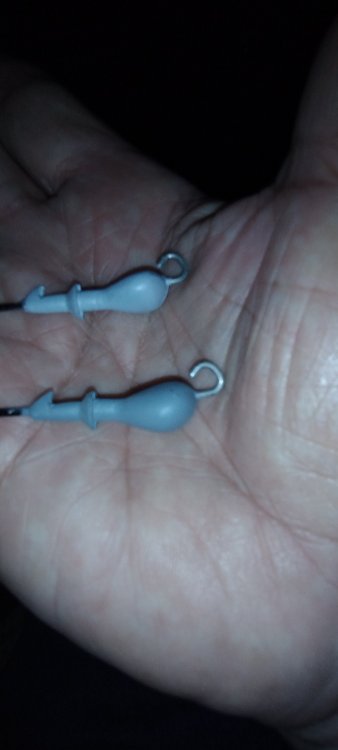-
Posts
14,656 -
Joined
-
Last visited
-
Days Won
356
Content Type
Profiles
Articles
TU Classifieds
Glossary
Website Links
Forums
Gallery
Store
Posts posted by mark poulson
-
-
On 4/18/2024 at 5:27 AM, basscatlildave said:
I pretty much use soft for action. I do add hardner when I want a little stiffer bait.
If you want to add hardener, mix it well into your cold plastic before you heat it, or all you'll wind up with is hard lumps.
-
From my experience with Solarez UV resin, I think any UV resin would add weight that would affect the side to side fall of a casting spoon.
-
 1
1
-
-
23 hours ago, bassclass said:
Thanks for sharing! you've made some pretty cool stuff. You had a picture of a speed trap body that you made from that PVC trim board. There really isn't anywhere near me that has Azek products. Do you know if any of the products major retailers like Menards, Lowes, Home Depot sell are similar buoyancy to that of the product you use?
Sorry, I don't know of any, but I'm sure they're out there. Most local lumber yards get samples of new products. See if they'll let you float test those to see which one is most buoyant. You can do it in a tupperware container full of their water.
-
On 4/12/2024 at 8:22 AM, cadman said:
Wow, that's pretty interesting. I didn't know that there were so many.
They used to be a common thing at arcades, carnivals, and theme parks, after WW2.
-
 1
1
-
-
Well done and congratulations!!!
-
Sorry, but all the baits I've made have been painted and finished.
If you look at my gallery photos there are some photos on the first couple of pages of pictures there are some baits I made that haven't been painted yet:
https://www.tackleunderground.com/community/profile/14932-mark-poulson/content/?type=gallery_image
-
Tiderunner said, "Make sure your injectors have locking nozzles."
He's right.
-
For your first question, I use two ways to increase buoyancy.
First, I increase buoyancy by drill holes in the top/back of my baits, and gluing discs from aluminum cans over them, to trap air inside and I cover the discs with a thin coat of bondo, so I can sand the bondo down to follow the bait's contours. When I'm done sanding/shaping, I add a drop or two of runny super glue to strengthen the bondo disc patch area.
Second, I actually use the natural buoyancy of the bait's material, because I use either wood or PVC trim board to make my baits from. I shape my baits with a V cross section, like the cross section of a battleship, so there is more buoyant material higher in the bait. That way I can add less ballast and still get a stable bait that is lighter and more active. Plus that shape keeps the bait from rolling or blowing out on a fast retrieve.
As to the second question, I've found that the wider the body and the wider the bill, the wider and more exaggerated the wobble. The reverse is also the case. A flatter sided body and narrower bill will have less wobble. That's why most commercial flat sided cranks also have narrower bills.
As far as how modifying your bait will affect it, every bait is different. When I modify a bait, I do it one thing at a time, so I can see what works, and know that I will ruin some bait in the process. I also use unpainted cheap knockoff blanks to do my experimenting on, so I'm not out a lot of money if they get ruined.
I hope this helps.
-
 1
1
-
-
I did something similar back in the '70s and my first two boys wore the trout out with them.
-
 1
1
-
-
I would replace it. They are cheap.
-
On 3/25/2024 at 8:45 AM, bass100 said:
Hey Mark, glad to see you are still around. It has been about a decade. I had to shut down the company and stop fishing due to medical problems but I am slowly getting back into it. This coating is something I would not use because I use PVC. This community is crafty so who knows what someone might want to do with it.
The reports of my death have been exaggerated, but just barely. Welcome back.
-
Nathan,
Didn't we play around with this stuff to use as a top coat years ago?
It rings a bell....
-
I use 24, and lay the 1" twisted tag end back along the hook to act as a bait keeper.
-
When I'm making a new-to-me lure, I start by looking at some of the successful commercial baits that are similar, and use them as a starting point.
One other thing I would try is taking the tail off completely to see if that helps. The longer the bait, the more stable/less action it will have, because there is more lure body inertia to overcome.
-
 1
1
-
-
-
-
1 hour ago, CNC Molds N Stuff said:
I forget who it was, but there used to be a de-facto expert here years ago who had put together a list of crazy dipping techniques that worked. I think he published a CD or something like that on it.
I'm not crazy about dipping at all myself. Its just to slow for me. If I want tubes I make a mold with an insert and I inject them. I do slice, but that's still faster than dipping.Bob, if you're thinking of Bojon, he died a while back.
-
 1
1
-
-
On 3/8/2024 at 10:16 AM, Outback Jack said:
I have made a DRT swim bait. Tiny klash imitation. Itsinks perfectly level.
very slow sink! Glides perfectly side to side. But if I retrieve it a little quick it wants to roll and even spin. Is this weight placement?Tohickon lure Co.
When I used to make jointed swimbaits, I found that the key to keeping them stable at higher retrieve speeds was to make the body taper from top to bottom, creating a V cross section. In my case, my swimbaits tapered from 7/8" at the top/back to 5/8" at the bottom/belly. This kept more buoyancy higher in the lure body, so I could put less ballast into the belly and still get the stable retrieve at higher speeds.
I actually started the taper about a third of the way down from the shoulders of the bait, as you can see in this picture"
It doesn't look like much, but it worked, so I could burn my swimbaits without them rolling.
-
 2
2
-
-
23 hours ago, CNC Molds N Stuff said:
That is so weird. I'm not sure what is happening, but its doesn't sound like tempering.
Various heat treating terms get thrown around all the time, and their slight misuse misunderstanding makes it hard to have a conversation sometimes.Tempering is used as defined above, to reduce the hardness of a metal that has been hardened. Why your hook appears to be getting harder from some sort of heat cycle is a weird one.
Many alloys at maximum hardness can shatter almost like glass. By making them less hard through "tempering" they become tougher... or less likely to break or shatter.
I read that reheating to 350-400 for an hour relieves the stresses that the initial heat hardening puts into the hook, or any metal that has been heat hardened. It seems to redistribute the stress more evenly throughout the metal, so it won't break.
-
I use my Do-It Arky weedless jig mold to pour 1/2oz vibrating jig heads, using Mustad 5/0 60 degree jig hooks, but I found the hook eyes would crack when I tried to open them to insert the chatter blade.
So I tried heating my hook eyes red hot with my torch, and that made them soft enough to open by driving an awl into them until I got enough gap to put the chatter blade on. That worked, but the hook eye felt soft and ovaled when I pinched it shut with the blade in place.
So I took a batch of the opened eye hooks and put them into my toaster oven for a hour at 350 degrees, the same temp I use to bake my powder coat, to retemper them.
When I pinched them closed this time I felt much more resistance, but none broke, so this is another step in my vibrating jig making process.
Success!
-
 1
1
-
-
I've had to turn off my adblock sometimes.
-
5 hours ago, Mad Moose Baits said:
OH! I made a video about this!
Years ago I had take a lead abatement class in order to keep my contractors license, and they went over many of the same things, but related it to removing lead-based paint in residential construction. Lead paint is a real threat for children.
My instructor emphasized that lead dust can also lead to sterility, but I think he was just trying to get the male case to pay attention.
It has been 20+ years since I had to worry about this, and things may have changed, but that's how it was in the 90's.
-
On 2/28/2024 at 7:26 AM, barrybait said:
Like Mark, I seal my wood wake and top water baits with slow cure epoxy like penetrating epoxy of Devcon (D2T). After I have done my shaping and have epoxied the hook hangars and the lip in place. Then I can use needle nose vise grips to hold the bait while I work on it. I think it helps to heat the wood bait with my heat gun before I apply the slow cure epoxy. That helps it pull the epoxy in as the wood cools. You can't really get the sides of the wood grain to absorb epoxy but end grain will. This makes the end and tapered sections harder and on my 2 piece baits I get a really great wood knock like that. Of course you will end up adding or moving weights as needed and you have to be diligent about sealing each hole. Be advised that warmed wood will make the epoxy more fumey, use an extraction fan or I use a fan blowing across my bench to keep the fumes away.
Barry is the Jedi Master of wood baits! I learned a lot of what I know about wood baits from him.
-
I shape (including ballast holes adding hardware hangers) and seal my baits with penetrating epoxy (epoxy thinned with alcohol), add ballast as needed to get them to suspend, seal the ballast holes, paint, and finish. For me, the paint and topcoat don't effect the suspension enough to worry about.
-
 2
2
-







3/4 oz Arky Jig
in Wire Baits
Posted
If you find a 3/4 oz Arky jig mold that has a vert. eye hook slot you can use a dremel ro a drill press to modify it to take a flat eye. I do the reverse and it's easy.